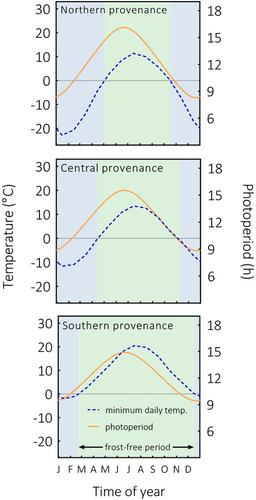当前位置:
X-MOL 学术
›
Glob. Change Biol.
›
论文详情
Our official English website, www.x-mol.net, welcomes your
feedback! (Note: you will need to create a separate account there.)
Variation in the phenology of photosynthesis among eastern white pine provenances in response to warming.
Global Change Biology ( IF 10.8 ) Pub Date : 2020-05-12 , DOI: 10.1111/gcb.15150 Emmanuelle Fréchette 1, 2 , Christine Yao-Yun Chang 1, 2 , Ingo Ensminger 1, 2, 3
Global Change Biology ( IF 10.8 ) Pub Date : 2020-05-12 , DOI: 10.1111/gcb.15150 Emmanuelle Fréchette 1, 2 , Christine Yao-Yun Chang 1, 2 , Ingo Ensminger 1, 2, 3
Affiliation

|
In higher‐latitude trees, temperature and photoperiod control the beginning and end of the photosynthetically active season. Elevated temperature (ET) has advanced spring warming and delayed autumn cooling while photoperiod remains unchanged. We assessed the effects of warming on the length of the photosynthetically active season of three provenances of Pinus strobus L. seedlings from different latitudes, and evaluated the accuracy of the photochemical reflectance index (PRI) and the chlorophyll/carotenoid index (CCI) for tracking the predicted variation in spring and autumn phenology of photosynthesis among provenances. Seedlings from northern, local and southern P. strobus provenances were planted in a temperature‐free‐air‐controlled enhancement (T‐FACE) experiment and exposed to ET (+1.5/3°C; day/night). Over 18 months, we assessed photosynthetic phenology by measuring chlorophyll fluorescence, gas exchange, leaf spectral reflectance and pigment content. During autumn, all seedlings regardless of provenance followed the same sequence of phenological events with the initial downregulation of photosynthesis, followed by the modulation of non‐photochemical quenching and associated adjustments of zeaxanthin pool sizes. However, the timing of autumn downregulation differed between provenances, with delayed onset in the southern provenance (SP) and earlier onset in the northern relative to the local provenance, indicating that photoperiod at the provenance origin is a dominant factor controlling autumn phenology. Experimental warming further delayed the downregulation of photosynthesis during autumn in the SP. A provenance effect during spring was also observed but was generally not significant. The vegetation indices PRI and CCI were both effective at tracking the seasonal variations of energy partitioning in needles and the differences of carotenoid pigments indicative of the stress status of needles. These results demonstrate that PRI and CCI can be useful tools for monitoring conifer phenology and for the remote monitoring of the length of the photosynthetically active season of conifers in a changing climate.
中文翻译:

东部白松种源对气候变暖的光合作用物候变化。
在高纬度树木中,温度和光周期控制着光合活动季节的开始和结束。高温(ET)使春季变暖提前,秋季冷却延迟,而光周期保持不变。我们评估了变暖对来自不同纬度的三种起源松树种苗光合有效季节长度的影响,并评估了光化学反射指数(PRI)和叶绿素/类胡萝卜素指数(CCI)的准确性以进行跟踪种源之间光合作用的春季和秋季物候变化的预测变化。北部,地方和南部P. strobus的幼苗种源种植在无温度空气控制增强(T-FACE)实验中,并暴露于ET(+ 1.5 / 3°C;昼/夜)。在18个月的时间里,我们通过测量叶绿素荧光,气体交换,叶片光谱反射率和色素含量评估了光合物候。在秋季,所有种苗,无论出处如何,都遵循相同的物候事件顺序,并开始下调光合作用,随后调节非光化学猝灭作用,并相应调节玉米黄质库的大小。然而,相对于本地种源,秋季下调的时机各不相同,南部种源(SP)的发病延迟和北部种源的北部发病较早,这表明种源的光周期是控制秋季物候的主要因素。实验性增温进一步延迟了SP秋季秋季光合作用的下调。在春季也观察到了物源效应,但通常不明显。植被指数PRI和CCI均能有效追踪针头能量分配的季节变化以及指示针头应力状态的类胡萝卜素色素的差异。这些结果表明,PRI和CCI可用于监视针叶树物候和在气候变化中远程监视针叶树光合有效季节长度的有用工具。植被指数PRI和CCI均能有效追踪针头能量分配的季节变化以及指示针头应力状态的类胡萝卜素色素的差异。这些结果表明,PRI和CCI可用于监视针叶树物候和在气候变化中远程监视针叶树光合有效季节长度的有用工具。植被指数PRI和CCI均能有效追踪针头能量分配的季节变化以及指示针头应力状态的类胡萝卜素色素的差异。这些结果表明,PRI和CCI可用于监视针叶树物候和在气候变化中远程监视针叶树光合有效季节长度的有用工具。
更新日期:2020-05-12
中文翻译:

东部白松种源对气候变暖的光合作用物候变化。
在高纬度树木中,温度和光周期控制着光合活动季节的开始和结束。高温(ET)使春季变暖提前,秋季冷却延迟,而光周期保持不变。我们评估了变暖对来自不同纬度的三种起源松树种苗光合有效季节长度的影响,并评估了光化学反射指数(PRI)和叶绿素/类胡萝卜素指数(CCI)的准确性以进行跟踪种源之间光合作用的春季和秋季物候变化的预测变化。北部,地方和南部P. strobus的幼苗种源种植在无温度空气控制增强(T-FACE)实验中,并暴露于ET(+ 1.5 / 3°C;昼/夜)。在18个月的时间里,我们通过测量叶绿素荧光,气体交换,叶片光谱反射率和色素含量评估了光合物候。在秋季,所有种苗,无论出处如何,都遵循相同的物候事件顺序,并开始下调光合作用,随后调节非光化学猝灭作用,并相应调节玉米黄质库的大小。然而,相对于本地种源,秋季下调的时机各不相同,南部种源(SP)的发病延迟和北部种源的北部发病较早,这表明种源的光周期是控制秋季物候的主要因素。实验性增温进一步延迟了SP秋季秋季光合作用的下调。在春季也观察到了物源效应,但通常不明显。植被指数PRI和CCI均能有效追踪针头能量分配的季节变化以及指示针头应力状态的类胡萝卜素色素的差异。这些结果表明,PRI和CCI可用于监视针叶树物候和在气候变化中远程监视针叶树光合有效季节长度的有用工具。植被指数PRI和CCI均能有效追踪针头能量分配的季节变化以及指示针头应力状态的类胡萝卜素色素的差异。这些结果表明,PRI和CCI可用于监视针叶树物候和在气候变化中远程监视针叶树光合有效季节长度的有用工具。植被指数PRI和CCI均能有效追踪针头能量分配的季节变化以及指示针头应力状态的类胡萝卜素色素的差异。这些结果表明,PRI和CCI可用于监视针叶树物候和在气候变化中远程监视针叶树光合有效季节长度的有用工具。











































 京公网安备 11010802027423号
京公网安备 11010802027423号